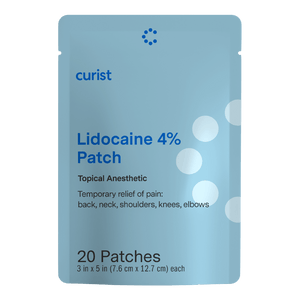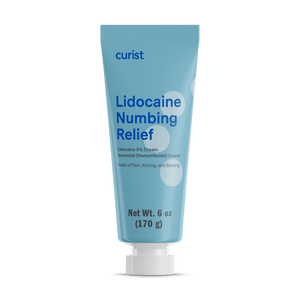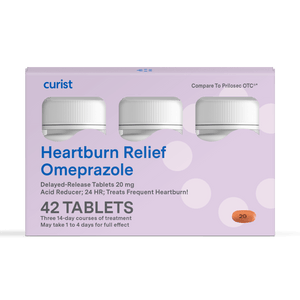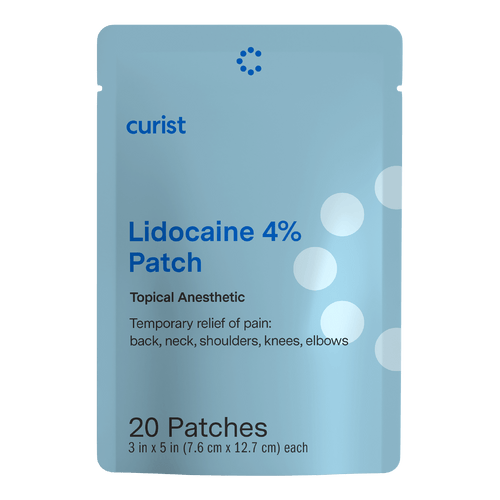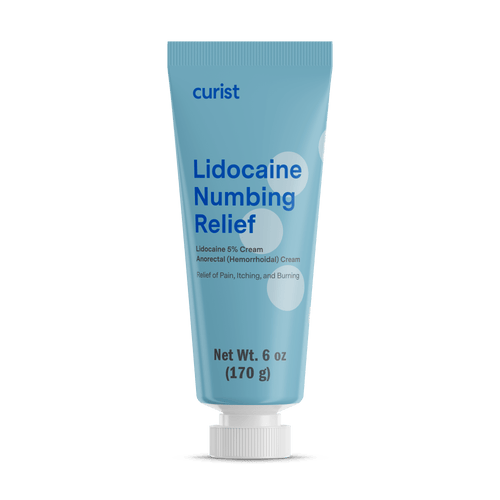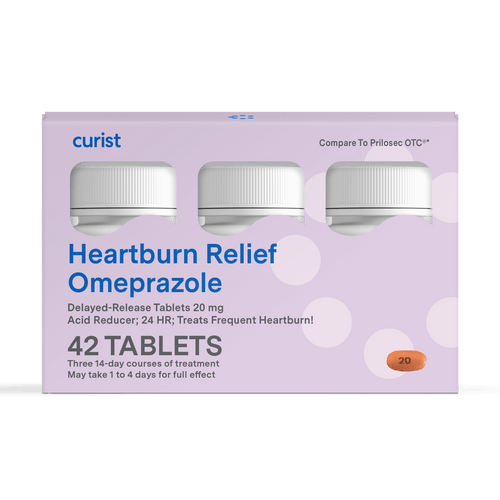By Deni Hui, The University of Texas at Austin College of Pharmacy
Curist delivers over-the-counter medicines to your door at a fraction of the price of traditional brands. We hope everyone stays safe and healthy during this time.
Lidocaine is a very popular local anesthetic used to treat symptoms of many painful episodes. Lidocaine topical comes in many different forms such as gel, spray, cream, lotion, ointment, liquid, or skin patch. Today in this article, we are going to learn more about what Lidocaine skin patches are, what kind of pain they can treat, and whether or not they are an ideal choice for your pain relief!
What are Lidocaine Patches? How Do Lidocaine Patches Work?
Lidocaine transdermal patch is a patch that attaches to your skin and contains the medication, lidocaine. Using a patch is easy and convenient! It is great for you if you do not want to worry about swallowing a pill every day, pain from injections, or messy gels.
Lidocaine patches work as local anesthetics. This means they ease pain by numbing your nerves in a specific area of your body and making them less sensitive to pain signals.
Do Lidocaine Patches Come in Different Strengths?
Lidocaine patches come in several different strengths and are designed for different uses. The lidocaine 5% patch and lidocaine 1.8% patch are prescription (RX) only, which means it requires a doctor to write a prescription. The lidocaine 5% and lidocaine 1.8% prescription patches are used to treat nerve pain caused by shingles, also known as postherpetic neuralgia, which must be done under the care of a doctor.
The lidocaine 4% patches are available over-the-counter (OTC) and do not require a prescription. The 4% OTC patch is indicated for temporary relief of minor aches and pains in shoulders, arms, neck and legs in adults and children 12 years of age and older.
Lidocaine Patch 5% vs 4% vs 1.8%: What does Each Lidocaine Patch Treat?
Lidocaine patches work as local anesthetics and are generally used to help relieve pain. And as briefly alluded to earlier, OTC lidocaine patches (4% lidocaine) can help relieve minor aches and pain conditions, including insect bites, burns, and pain in different areas of the body. Because lidocaine can numb your nerves, these patches may also be helpful for treating neuropathic (nerve) pain. This is pain caused by nerve damage.
Nerve pain is caused by various conditions (e.g. diabetes, HIV, shingles, cancer, alcoholism, etc) and can present differently for everyone. Some of the tell-tale signs of nerve pain include ‘shooting’, ‘tingling’, ‘pins and needles’, or ‘burning’ pain.
In addition to the OTC patches, certain lidocaine patches (5% and 1.8% lidocaine patches) are also available by prescription for a specific and more severe kind of nerve pain (e.g. postherpetic neuralgia). If you find OTC lidocaine patches are not effective in relieving your pain, reach out to your healthcare provider and discuss the need to potentially move to a prescription product.
Who Should Use Lidocaine Patches?
There are a few things to consider when deciding whether lidocaine patches are an ideal option for you. As always, it is important to check with your healthcare provider first prior to starting any pain relief regimen.
First and foremost, you have to identify what type of pain you are experiencing. Is it nerve pain or muscle pain? If you have any signs of nerve pain as described above, lidocaine patches may be right for you. If you are experiencing localized pain in areas of your shoulders, neck, arms, or legs, lidocaine patches may also work for you. However, if you are experiencing pain that is related to swelling or inflammation, like arthritis, lidocaine patches may not be the best option for you. Lidocaine patches do not work well to treat inflammation-type of pain. NSAIDs, like ibuprofen and naproxen, may be more effective and helpful for pain caused by inflammation.
The second consideration is to determine the location and intensity of your pain. Is your pain in only one area or in many areas? Lidocaine patches are local anesthetics. They only work around the area where you’ve attached the patch to, so they are particularly useful if you have pain in a specific, localized area of your body. If you feel pain throughout your whole body, you might need something else that can help relieve pain in multiple areas. Lidocaine patches in these circumstances may not be a good fit for you. Medications such as acetaminophen or oral nerve pain medications, like gabapentin or duloxetine may be preferable for systemic pain.
Last but not least, it is important to consider what works best for you. Lidocaine patches may be a convenient option for you if you want to avoid certain forms of pain medications such as swallowing pills, applying gels, or taking injections.
How Long Do the Effects of Lidocaine Patches Last?
Lidocaine patches generally have a quick onset of action. Most people can expect some pain relief on the first day of using the patch, but for some, it may take up to 2-4 weeks of using the patch every day before full effects are seen. Once the patch is applied, the pain-relieving effects can last up to 12 hours. After that, you will need to remove the old patch and apply a new one. Just a note, the OTC 4% lidocaine patch can be used for up to 3 times daily and for no more than 12 hours per application.
What are the Common Side Effects of Lidocaine Patches?
Lidocaine patches are all considered well tolerated medications with minimal side effects. Most people do not experience side effects from using them, but it is possible to experience redness, itching, or skin irritation in the area where you applied the patch to. If you experience any dizziness, headache, sleepiness, change in taste (e.g. metallic taste) or vision (e.g. blurry or double vision) while using lidocaine patches, you should speak with your healthcare provider immediately.
Can I Overdose on Lidocaine Patch?
Overdosing on lidocaine is rare when the patches are used strictly according to the package instructions. The incidence is rare due to two main reasons. First, the medication works only on a specific and small area of the body rather than on the entire body. Second, the strength of lidocaine in the patches is relatively low, which means the risk of absorbing toxic levels into your bloodstream is minimal. However, it is important to recognize signs of lidocaine overdose which may include confusion, euphoria (extreme happiness), seizures, low heart rate, trouble breathing, or cardiac arrest. If any of these happen to you or your loved one(s), call 911 immediately as lidocaine overdoses can be life-threatening.
Where Can I Buy Lidocaine Patch?
Lidocaine patches are easily found over the counter (OTC) at your local pharmacy as well as stores online like Curist, and do not need a prescription.
At Curist, we develop FDA-approved equivalents to big brands in order to provide the same medicine relief but at half the price of the brands. Curist products are sold online and shipped directly to your door. To learn more, shop Curist Lidocaine Patch 4% Maximum Strength.




